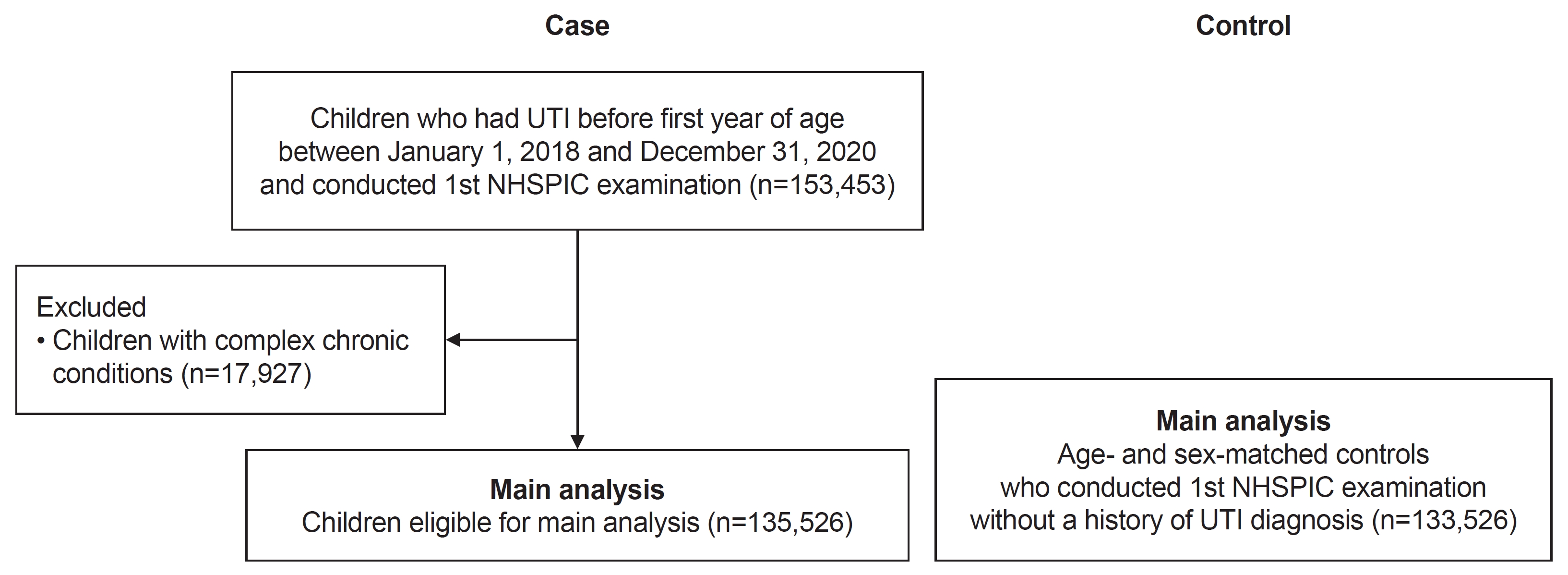Child Kidney Dis.
2023 Dec;27(2):111-116. 10.3339/ckd.23.020.
Association of body weight and urinary tract infections during infancy: a nationwide comparative matched cohort study
- Affiliations
-
- 1Department of Pediatrics, Seoul National University Children’s Hospital, Seoul, Republic of Korea
- 2Department of Pediatrics, Seoul National University Bundang Hospital, Seongnam, Republic of Korea
- 3Department of Pediatrics, Seoul National University College of Medicine, Seoul, Republic of Korea
- 4Kidney Research Institute, Medical Research Center, Seoul National University, Seoul, Republic of Korea
- KMID: 2549742
- DOI: http://doi.org/10.3339/ckd.23.020
Abstract
- Purpose
This article was to investigate the association between urinary tract infections (UTIs) and high weight status in infancy.
Methods
We conducted a nationwide matched cohort study from January 2018 to December 2020 using data from the Korean National Health Insurance System and the Korean National Health Screening Program for Infants and Children. We analyzed the association between UTI diagnosis codes and high weight status (which was defined as being in the 90th percentile or higher of weight-for-age).
Results
We found that 22.8% of infants with UTIs exhibited high weight status, compared to 20.0% of non-UTI infants (P<0.001). Per our multivariable analyses, the adjusted odds ratio for high weight status was 1.09 (95% confidence interval, 1.06–1.13).
Conclusions
UTI in the first 12 months of life was associated with a weight-for-age percentile of ≥90. Our findings corroborate those of previous single-center studies and emphasize the importance of careful monitoring for this at-risk group.
Keyword
Figure
Reference
-
References
1. Kaufman J, Temple-Smith M, Sanci L. Urinary tract infections in children: an overview of diagnosis and management. BMJ Paediatr Open. 2019; 3:e000487.
Article2. Shaikh N, Morone NE, Bost JE, Farrell MH. Prevalence of urinary tract infection in childhood: a meta-analysis. Pediatr Infect Dis J. 2008; 27:302–8.3. Wennerstrom M, Hansson S, Jodal U, Sixt R, Stokland E. Renal function 16 to 26 years after the first urinary tract infection in childhood. Arch Pediatr Adolesc Med. 2000; 154:339–45.
Article4. Vogels N, Posthumus DL, Mariman EC, Bouwman F, Kester AD, Rump P, et al. Determinants of overweight in a cohort of Dutch children. Am J Clin Nutr. 2006; 84:717–24.
Article5. Dobner J, Kaser S. Body mass index and the risk of infection: from underweight to obesity. Clin Microbiol Infect. 2018; 24:24–8.6. Grier WR, Kratimenos P, Singh S, Guaghan JP, Koutroulis I. Obesity as a risk factor for urinary tract infection in children. Clin Pediatr (Phila). 2016; 55:952–6.
Article7. Hsu PC, Chen SJ. Obesity and risk of urinary tract infection in young children presenting with fever. Medicine (Baltimore). 2018; 97:e13006.
Article8. Yang TH, Yim HE, Yoo KH. Obesity and a febrile urinary tract infection: dual burden for young children? Urology. 2014; 84:445–9.
Article9. Gao X, Jia R, Xie L, Kuang L, Feng L, Wan C. Obesity in school-aged children and its correlation with gut E.coli and Bifidobacteria: a case-control study. BMC Pediatr. 2015; 15:64.
Article10. Ju T, Bourrie BCT, Forgie AJ, Pepin DM, Tollenaar S, Sergi CM, et al. The gut commensal escherichia coli aggravates high-fat-diet-induced obesity and insulin resistance in mice. Appl Environ Microbiol. 2023; 89:e0162822.
Article11. Yim HE, Han KD, Kim B, Yoo KH. Impact of early-life weight status on urinary tract infections in children: a nationwide population-based study in Korea. Epidemiol Health. 2021; 43:e2021005.
Article12. Moon JS. Review of National Health Screening Program for Infant and Children in Korea. J Korean Med Assoc. 2010; 53:377–85.
Article13. Eun BL, Moon JS, Eun SH, Lee HK, Shin SM, Sung IK, et al. The current child and adolescent health screening system: an assessment and proposal for an early and periodic check-up program. Korean J Pediatr. 2010; 53:300–6.
Article14. National Health Insurance Service. 2021 National health insurance statistical yearbook [Internet]. National Health Insurance Service;2023 [cited 2023 Jun 6]. Available from: https://www.nhis.or.kr/nhis/together/wbhaec06300m01.do?mode=view&articleNo=10829400&article.offset=0&articleLimit=10.15. Feudtner C, Feinstein JA, Zhong W, Hall M, Dai D. Pediatric complex chronic conditions classification system version 2: updated for ICD-10 and complex medical technology dependence and transplantation. BMC Pediatr. 2014; 14:199.
Article16. Renko M, Salo J, Ekstrand M, Pokka T, Pievilainen O, Uhari M, et al. Meta-analysis of the Risk Factors for Urinary Tract Infection in Children. Pediatr Infect Dis J. 2022; 41:787–92.
Article17. Milner JJ, Beck MA. The impact of obesity on the immune response to infection. Proc Nutr Soc. 2012; 71:298–306.
Article18. Ouchi N, Parker JL, Lugus JJ, Walsh K. Adipokines in inflammation and metabolic disease. Nat Rev Immunol. 2011; 11:85–97.
Article
- Full Text Links
- Actions
-
Cited
- CITED
-
- Close
- Share
- Similar articles
-
- Clinical Studies of Urinary Tract Infection in Infancy and Childhood
- Clinical Study of Urinary Tract Infection in Children and Infancy and the Significance of IVP
- Comparative studies on the screeing tests of the urinary tract infections during pregnancy
- Impact of early-life weight status on urinary tract infections in children: a nationwide population-based study in Korea
- Treatment of urinary tract infections


